Monthly Archives: May 2018
Becoming parents for the first time is such an amazing thing. You are in awe of the beautiful gift God has given you, and you can’t wait to see them grow and become the person they are destined to be. Today was that special day for my grandson, Chris Petersen, and his beautiful fiance, Karen, when their daughter made her grand entrance into the world yesterday, May 30, 2018 at 4:35pm. She weighed in at 7 pounds 2 ounces. She was 19¼ inches long. She has soft wisps of brown hair, just like her parents did, and she is absolutely beautiful.
Their baby’s arrival has brought with it many changes in my family. Of course, Chris and Karen became parents, but also, my daughter, Corrie Petersen and her husband, Kevin became grandparents. Their other son, Josh became an uncle. My daughter, Amy Royce and her husband, Travis became great aunt and great uncle, and their children, Shai and Caalab now have a 1st cousin once removed. My husband, Bob and I are now great grandparents. And of course, there were the same changes for Karen’s family for her parents are now grandparents. And this baby has multiple great grandparents, and even one great great grandmother. Her siblings are now aunts and uncles. It’s an exciting day for sure.
My great granddaughter is a sweet little baby girl, who loves to cuddle with those holding her. She was wide awake, even after having a full day of work just being born. Everyone knows labor and delivery is a tough job on the mom, but the baby has a lot of work to do too, and it can be quite exhausting for those little babies. Nevertheless, she was excited to see what was going on around her, so she had her eyes wide open. What I found really special is how she just snuggled up to her daddy. She knew his voice from hearing him talk before she was born, and she cuddled up to him as if to say, “That’s my Daddy!” I find it so amazing that these babies can know their parents voices from inside the womb and so quickly relate to it after their birth. Such a sweet bond to both mommy and daddy. When her mommy had her, she was totally content. She would have snuggled up and stayed right there for the rest of the day. This pretty girl is a sweet combination of both of her parents, and we are just so in love with her. She has a big family who all love her very much and we can’t wait for all the wonderful times to come. Congratulations to Karen and Chris, your beautiful little family is growing, and we are so excited for the future!! We are so happy for you!!
 My grandnephew, Jaxx Harman is a sweet, good natured little boy who is very patient with his older sisters, who love to “mother” him. Having two older sisters can be a difficult thing for a little boy, but not Jaxx. He loves his sisters, and really wants to go play with them. He can’t walk yet, so he is limited as to what he can do, but he crawls, and I can tell you from my own experience, that many babies can crawl much faster than their older siblings. Of course, they can run, so that gets them ahead of the ones
My grandnephew, Jaxx Harman is a sweet, good natured little boy who is very patient with his older sisters, who love to “mother” him. Having two older sisters can be a difficult thing for a little boy, but not Jaxx. He loves his sisters, and really wants to go play with them. He can’t walk yet, so he is limited as to what he can do, but he crawls, and I can tell you from my own experience, that many babies can crawl much faster than their older siblings. Of course, they can run, so that gets them ahead of the ones  who crawl, but Jaxx’s sisters, Alice and Izabella, love their little brother too, and they try to keep him in the loop with their activities. It won’t be long before Jaxx is right up there walking and running with his sisters. He is already able to stand against furniture, provided that someone gets him up to the furniture, so it won’t be long before he figures all of it out for himself, and then…look out…here comes Jaxx!!
who crawl, but Jaxx’s sisters, Alice and Izabella, love their little brother too, and they try to keep him in the loop with their activities. It won’t be long before Jaxx is right up there walking and running with his sisters. He is already able to stand against furniture, provided that someone gets him up to the furniture, so it won’t be long before he figures all of it out for himself, and then…look out…here comes Jaxx!!
Jaxx has definitely found his voice, and his funny bone. He laughs often, as well as plenty of squeals and hollers. And he has an adorably cute cheesy smile that is totally contagious. He definitely keeps his family entertained with all his antics. He is very lovable, and loves life. Jaxx is all boy, however, and I’m sure that it won’t be long before his sisters’ toys become to girly for him. Nevertheless, he will probably play their games  with them anyway, because he is an easygoing sort of guy. When it comes to food, Jaxx is ready to eat…anything that is put in front of him. He isn’t a picky eater at all, but he especially loves his strawberry milk. That takes me back to my young life, and I think, most kids. Flavored milk is where it’s at. I loved chocolate and strawberry milk, but then, I loved milk…period. As for Jaxx, strawberry milk is his go to flavor, and he will drink as much of it as his mommy will let him. And I think that with his sweet smile,his mommy and daddy, Melanie and Jake Harman are hard pressed to keep from giving in to this sweet little boy. Today is Jaxx’s 1st birthday. Happy birthday sweet Jaxx!! Have a great day!! We love you!!
with them anyway, because he is an easygoing sort of guy. When it comes to food, Jaxx is ready to eat…anything that is put in front of him. He isn’t a picky eater at all, but he especially loves his strawberry milk. That takes me back to my young life, and I think, most kids. Flavored milk is where it’s at. I loved chocolate and strawberry milk, but then, I loved milk…period. As for Jaxx, strawberry milk is his go to flavor, and he will drink as much of it as his mommy will let him. And I think that with his sweet smile,his mommy and daddy, Melanie and Jake Harman are hard pressed to keep from giving in to this sweet little boy. Today is Jaxx’s 1st birthday. Happy birthday sweet Jaxx!! Have a great day!! We love you!!
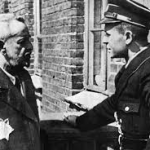
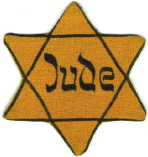 Over the centuries, people have gone to great lengths to humiliate their enemies. The worst thing for the Jewish people was that over the centuries, there have been so many enemies. To this day, it doesn’t matter that Israel is one of the smallest nations in the world, the Muslim nations don’t even want them to have that small area, and the Muslims weren’t the only enemy of the Jewish people either. The Jews of Europe were legally forced to wear badges or distinguishing garments, like pointed hats, to let everyone know who they were. This practice began at least as far back as the 13th century. It continued throughout the Middle Ages and Renaissance, but was then largely phased out during the 17th and 18th centuries. With the coming of the French Revolution and the emancipation of western European Jews throughout the 19th century, the wearing of Jewish badges was abolished in Western Europe.
Over the centuries, people have gone to great lengths to humiliate their enemies. The worst thing for the Jewish people was that over the centuries, there have been so many enemies. To this day, it doesn’t matter that Israel is one of the smallest nations in the world, the Muslim nations don’t even want them to have that small area, and the Muslims weren’t the only enemy of the Jewish people either. The Jews of Europe were legally forced to wear badges or distinguishing garments, like pointed hats, to let everyone know who they were. This practice began at least as far back as the 13th century. It continued throughout the Middle Ages and Renaissance, but was then largely phased out during the 17th and 18th centuries. With the coming of the French Revolution and the emancipation of western European Jews throughout the 19th century, the wearing of Jewish badges was abolished in Western Europe.
Enter Hitler. The Nazis, under Hitler’s direction, resurrected this practice as part of humiliation tactics during the Holocaust. Reinhardt Heydrich, chief of the Reich Main Security Office, first recommended that Jews should wear identifying badges following the Kristallnacht pogrom of November 9 and 10, 1938. Hitler liked the idea, because Hitler hated the Jews. Shortly after the invasion of Poland in September 1939, local German authorities began introducing mandatory wearing of badges. By the end of 1939, all Jews in the newly-acquired Polish territories were required to wear badges. Upon invading the Soviet Union in June 1941, the Germans again required the Jews in the newly-conquered lands to wear badges. Throughout the rest of 1941 and 1942, Germany, its satellite states and western occupied territories adopted regulations stipulating that Jews wear identifying badges. On May 29, 1942, on the advice of Nazi propaganda minister Joseph Goebbels, Adolf Hitler orders all Jews in occupied Paris to wear an identifying yellow star on the left side of their coats. Only in Denmark, where King Christian X is said to have threatened to wear the badge himself if it were imposed on his country’s Jewish population, were the Germans unable to impose such a regulation. Too bad some of the other nations did not stand up for the Jewish people too.
The Yellow Star was imposed on the Jewish people as part of many psychological tactics aimed at isolating and dehumanizing the Jews of Europe and especially by the Nazis. They were being directly marked as being different and inferior to everyone else. It also allowed the Germans to facilitate their separation from society and subsequent ghettoization, which ultimately led to the deportation and murder of 6 million Jews. Those who failed or refused to wear the badge risked severe punishment, including death. For example, the Jewish Council (Judenrat) of the ghetto in Bialystok, Poland announced that “… the authorities have warned that severe punishment – up to and including death by shooting – is in store for Jews who do not wear the yellow badge on back and front.” The star took on different forms in different regions, but everyone in the area knew what it 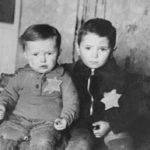
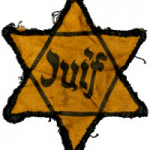 meant. Of course, the Jewish people hated the badge for what it symbolized, even though the Star of David had stood for the Jewish people since about the 12th century. While the Star of David, known as the Magen David, has continued to be the unofficial symbol of the Jewish people, even on their flag, the Menorah continues to be the official symbol of Judaism (The Jewish people). It seems to me that they would not really want the Star of David after all of the persecution that has been associated with it, but I guess it could be looked at as a badge of honor, as they, as a people survived the persecution.
meant. Of course, the Jewish people hated the badge for what it symbolized, even though the Star of David had stood for the Jewish people since about the 12th century. While the Star of David, known as the Magen David, has continued to be the unofficial symbol of the Jewish people, even on their flag, the Menorah continues to be the official symbol of Judaism (The Jewish people). It seems to me that they would not really want the Star of David after all of the persecution that has been associated with it, but I guess it could be looked at as a badge of honor, as they, as a people survived the persecution.
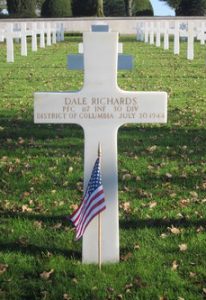 Memorial Day…an often misunderstood day, is actually a day to remember those military men and women who paid the ultimate price for our freedom…they gave their life in service to their country. Whether we know it or not, I’m sure that every family has lost a love one to war…some war in history. It might be many years in the past, and we may not even know about it at all, nevertheless, it is our duty to remember and to honor them, because they sacrificed their very lives that we might live in a free nation. It is so hard to think of someone that we care about, being killed in a foreign country while fighting a war.
Memorial Day…an often misunderstood day, is actually a day to remember those military men and women who paid the ultimate price for our freedom…they gave their life in service to their country. Whether we know it or not, I’m sure that every family has lost a love one to war…some war in history. It might be many years in the past, and we may not even know about it at all, nevertheless, it is our duty to remember and to honor them, because they sacrificed their very lives that we might live in a free nation. It is so hard to think of someone that we care about, being killed in a foreign country while fighting a war.
I am one of those people who doesn’t personally know of a family member lost in a war, but my Uncle Jim Richards brother, Dale was lost on the beaches of Normandy France on July 30, 1944. It is incomprehensible to me to think of his family getting word of his passing, only to find out that they would have to foot the bill to bring him home for burial. There simply were not enough funds, and so Dale was buried at the Brittany American Cemetery and Memorial, in Normandy, France. I can’t begin to imagine the awful day when the summer suddenly seemed as cold as ice. No parent should have to outlive their child, but with war comes death, and someone’s son or daughter will not be coming home again. I heard it put best in a song by Tim McGraw. The song, If you’re Reading This talks about getting a “one way ticket” over there. Unfortunately, far too many of our young men and women have been given that one way ticket, and while they paid with their lives, their families paid too. Their loved one is forever take from them, and they are left to mourn…to try to go on with their lives.
So many people look at Memorial Day as a holiday…a day to hold picnics, sports events and family gatherings. This day is traditionally seen as the start of the summer season for cultural events. For the fashion conscious, it is seen as acceptable to wear white clothing, particularly shoes from Memorial Day until Labor Day. However, fewer and fewer people follow this rule and many wear white clothing throughout the year. But how should we, the living, best honor the lives of all those who have died in service to our country? On Memorial Day, it is traditional to fly the flag of the United States at half staff from dawn until noon. Many people visit cemeteries 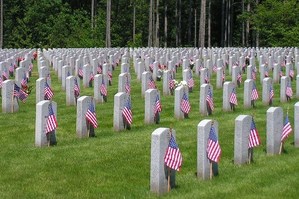 and memorials, particularly to honor those who have died in military service. Many volunteers place an American flag on each grave in national cemeteries. in reality, this is a day to reflect on the sacrifices made to keep us free. While we feel like we should be honoring veterans who have passed away, the reality is that their day is Veterans Day, which honors the veterans of all wars living or dead. Within the military, there is a very strict protocol concerning the days we honor military personnel. The other thing that we tend to find odd about Memorial Day, is that we can’t go to someone and thank them for their sacrifice, because the way they came to be honored is to have given their life for their country. All we can do is to honor their memory.
and memorials, particularly to honor those who have died in military service. Many volunteers place an American flag on each grave in national cemeteries. in reality, this is a day to reflect on the sacrifices made to keep us free. While we feel like we should be honoring veterans who have passed away, the reality is that their day is Veterans Day, which honors the veterans of all wars living or dead. Within the military, there is a very strict protocol concerning the days we honor military personnel. The other thing that we tend to find odd about Memorial Day, is that we can’t go to someone and thank them for their sacrifice, because the way they came to be honored is to have given their life for their country. All we can do is to honor their memory.
 Many people have said they saw a flying saucer, and most have been laughed at, as the people they told about the flying saucer just couldn’t believe it was real. I’m not going to try to prove or disprove the flying saucer from outer space, but rather, I want to talk about the flying saucers of the United States Air Force. I can’t say if the flying saucers people have seen were actually the US Air Force’s Lenticular Reentry Vehicle, which was originally under research in the late 1950s. The Convair/Pomona division of General Dynamics initiated a project entitled Pye Wacket. The purpose of the project was to determine the feasibility of developing a missile-defense system based on flying discs…known as Lenticular vehicles. Although Pye Wacket was terminated by 1961, research had shown Lenticular-shaped vehicles possessed sound re-entry characteristics.
Many people have said they saw a flying saucer, and most have been laughed at, as the people they told about the flying saucer just couldn’t believe it was real. I’m not going to try to prove or disprove the flying saucer from outer space, but rather, I want to talk about the flying saucers of the United States Air Force. I can’t say if the flying saucers people have seen were actually the US Air Force’s Lenticular Reentry Vehicle, which was originally under research in the late 1950s. The Convair/Pomona division of General Dynamics initiated a project entitled Pye Wacket. The purpose of the project was to determine the feasibility of developing a missile-defense system based on flying discs…known as Lenticular vehicles. Although Pye Wacket was terminated by 1961, research had shown Lenticular-shaped vehicles possessed sound re-entry characteristics.
The project was classified as secret in 1962, but cleared for public information release December 28, 1999. It’s declassified technical report had been compiled by R J Oberto, Los Angeles Division of North American Aviation.  His report described the Lenticular Reentry Vehicle as an offensive weapons system. Popular Mechanics obtained information on the Lenticular Reentry Vehicle from a Freedom of Information Act request after documents describing the project were declassified in 1999. “The Lenticular Reentry Vehicle,” according to a November 2000 Popular Mechanics cover story, “was an experimental nuclear warhead delivery system under development during the Cold War by defense contractor North American Aviation, managed out of Wright-Patterson Air Force Base in Dayton, Ohio.” According to Oberto’s report, “the Lenticular Reentry Vehicle was a 40 foot half-saucer with a flat rear edge. The design-study documents indicated it could support a crew of four men for six-week orbital missions. Propulsion was from a rocket engine…either chemical or nuclear, and the craft would also have contained an onboard nuclear reactor for electrical power generation.”
His report described the Lenticular Reentry Vehicle as an offensive weapons system. Popular Mechanics obtained information on the Lenticular Reentry Vehicle from a Freedom of Information Act request after documents describing the project were declassified in 1999. “The Lenticular Reentry Vehicle,” according to a November 2000 Popular Mechanics cover story, “was an experimental nuclear warhead delivery system under development during the Cold War by defense contractor North American Aviation, managed out of Wright-Patterson Air Force Base in Dayton, Ohio.” According to Oberto’s report, “the Lenticular Reentry Vehicle was a 40 foot half-saucer with a flat rear edge. The design-study documents indicated it could support a crew of four men for six-week orbital missions. Propulsion was from a rocket engine…either chemical or nuclear, and the craft would also have contained an onboard nuclear reactor for electrical power generation.”
The existence of the Lenticular Reentry Vehicle program may bring credence to the idea of the military flying  saucers theory concerning unidentified flying objects, but the flight characteristics of the Lenticular Reentry Vehicle, as described by the documents released, are more similar to a standard orbital space capsule of the 1960s era, rather than the rapid motion and sudden velocity change characteristics of many reported UFOs. As of the publication of the Popular Mechanics article, there has been no official confirmation that the Lenticular Reentry Vehicle ever flew. Dynamic analysis of Lenticular missile configurations was conducted by the General Dynamics Pomona Division under Army Missile Command contract in the 1963. So, I guess the final decision goes to each person. Is it a UFO from outer space, or is it a Lenticular Reentry Vehicle (LRV) from the US Air Force?
saucers theory concerning unidentified flying objects, but the flight characteristics of the Lenticular Reentry Vehicle, as described by the documents released, are more similar to a standard orbital space capsule of the 1960s era, rather than the rapid motion and sudden velocity change characteristics of many reported UFOs. As of the publication of the Popular Mechanics article, there has been no official confirmation that the Lenticular Reentry Vehicle ever flew. Dynamic analysis of Lenticular missile configurations was conducted by the General Dynamics Pomona Division under Army Missile Command contract in the 1963. So, I guess the final decision goes to each person. Is it a UFO from outer space, or is it a Lenticular Reentry Vehicle (LRV) from the US Air Force?

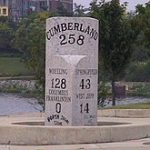 George Washington and Thomas Jefferson believed that a trans-Appalachian road was necessary to connect this young country. In 1806 Congress authorized construction of the road and President Jefferson signed the act establishing the National Road. It would connect Cumberland, Maryland to the Ohio River. Construction on the road, known in many places as Route 40, and in others as the Cumberland Road, began in 1811 and continued until 1834. It was designed to reach the western settlements, and was the first federally funded road in United States history.
George Washington and Thomas Jefferson believed that a trans-Appalachian road was necessary to connect this young country. In 1806 Congress authorized construction of the road and President Jefferson signed the act establishing the National Road. It would connect Cumberland, Maryland to the Ohio River. Construction on the road, known in many places as Route 40, and in others as the Cumberland Road, began in 1811 and continued until 1834. It was designed to reach the western settlements, and was the first federally funded road in United States history.
The first contract was awarded in 1811, and included the first 10 miles of road. These days that seems like such a short distance, but in the early 1800s, I’m sure it was considered a big job. By 1818 the road was completed to Wheeling, West Virginia. It was at this point that mail coaches began using the road. By the 1830s the federal government turned over part of the road’s maintenance responsibility to the states through which it ran. In order to help pay for the road’s upkeep, tollgates and tollhouses were built by the states. As work on the road progressed a settlement pattern developed that is still visible. Original towns and villages that were found along the National Road, remain barely touched by the passing of time. The road, also called the Cumberland Road, National Pike and other names, became Main Street in these early settlements, earning the nickname “The Main Street of America.” The height of the National Road’s popularity came in 1825 when it was celebrated in song, story, painting and poetry, but hard times hit in 1834, and construction on the road was tabled. During the 1840s popularity soared again. Travelers and drovers, westward bound, crowded the inns and taverns along the route. Huge Conestoga wagons hauled produce from farms on the frontier to the East Coast, and then returned with staples such as coffee and sugar for the western settlements. Thousands of people moved west in covered wagons and stagecoaches that traveled the road keeping to regular schedules.
In the 1870s, however, the railroads came and some of the excitement of the national road faded. In 1912 the road became part of the National Old Trails Road and its popularity returned in the 1920s with the automobile. Federal Aid became available for improvements in the road to accommodate the automobile. In 1926 the road became part of US 40 as a coast-to-coast highway. As the interstate system has grown throughout America, interest in the National Road again waned. However, now when we want to have a relaxing journey with some history thrown in, we again travel the National Road. Cameras capture old buildings, bridges and old stone mile markers. Old brick schoolhouses from early years sporadically dot the countryside and some are found in the small towns on the National Road. Many are still used, some are converted to a private residence and others stand abandoned.
Historic stone bridges dot their way along the National Road, and they have their own stories to tell. The craftsmanship of the early engineers was amazing. The S Bridge, was so named because of its design and it stands 4 miles east of Old Washington, Ohio. It was built in 1828 as part of the National Road. It is a single arch stone structure. This one of four in the state is deteriorated and is now used for only pedestrian traffic. However the owners of the bridge are attempting to obtain funding for its restoration. The stone Casselman River Bridge still stands east of Grantsville, Maryland. It is a product of the early 19th century federal government improvements program along the National Road, the Casselman River Bridge was constructed in 1813-1814. Its 80-foot span, is the largest of its type in America, and it connected Cumberland to the Ohio River. In 1933 a new steel bridge joined the banks of the Casselman River. The old stone bridge, partially restored by the State of Maryland in the 1950s is now the center of Casselman River Bridge State Park. Mile markers have been used in Europe for more than 2,000 years and our European ancestors continued that tradition here in America. These markers tell travelers how far they are from their destination and were an important icon in early National Road travel. Kids ask what they are fr, and adults nostalgically seek them out for photographing. A drive through National Road towns usually reveals one of these markers, such as the one standing by the historic Red Brick Tavern in Lafayette, Ohio.
In the 1960s Interstate 70, bypassed Route 40 and much of the National Road, leaving many businesses by the wayside. People were looking for faster cars and quicker arrival times. Life runs at a much faster pace these 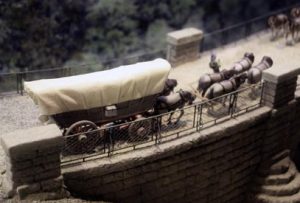
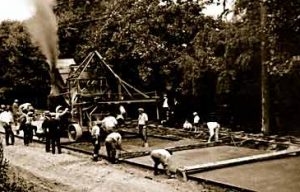 days. These old roads are a great way to relax, take your time and see some sights. Traveling the National Road, you can see the timeless little villages with small restaurants where you can get a home cooked meal and a trip back in time. The Interstate often parallels the National Road, but we leave behind the old inns and farmhouses in our rush to arrive about destination.
days. These old roads are a great way to relax, take your time and see some sights. Traveling the National Road, you can see the timeless little villages with small restaurants where you can get a home cooked meal and a trip back in time. The Interstate often parallels the National Road, but we leave behind the old inns and farmhouses in our rush to arrive about destination.
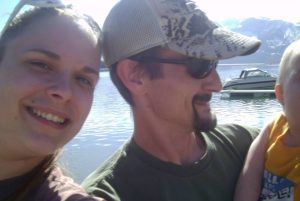 My niece, Cassie Iverson is a patient, loving mother of two beautiful children 6 year old Lucas, and 2 year old Zoey. She loves to go camping with the family, and they go as often as they can, because Cassie is a photographer, and is drawn to the beautiful side of life. Much of her photography is of nature, which appeals to me very much, as a nature lover too. Good photography requires an eye for staging. It’s strange to thing of staging the shot for nature, but things like what is centered, how much to zoom, and good lighting are vital to taking a great picture. Cassie has that eye for staging, and so her pictures come of beautiful and they draw you into the scene.
My niece, Cassie Iverson is a patient, loving mother of two beautiful children 6 year old Lucas, and 2 year old Zoey. She loves to go camping with the family, and they go as often as they can, because Cassie is a photographer, and is drawn to the beautiful side of life. Much of her photography is of nature, which appeals to me very much, as a nature lover too. Good photography requires an eye for staging. It’s strange to thing of staging the shot for nature, but things like what is centered, how much to zoom, and good lighting are vital to taking a great picture. Cassie has that eye for staging, and so her pictures come of beautiful and they draw you into the scene.
She takes pictures of her children and of other people too, and she has a great 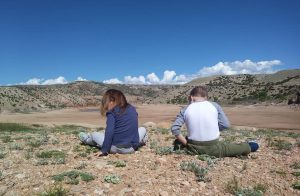 eye for staging those photos too, but her real love for photography lies in photographing nature. It makes perfect sense, since she loves to be camping more than living in town. She and her husband, Chris like to fish and camp out with the kids…showing them all the beauty that nature has to offer. While she loves photography, Cassie’s kids really are her whole heart.
eye for staging those photos too, but her real love for photography lies in photographing nature. It makes perfect sense, since she loves to be camping more than living in town. She and her husband, Chris like to fish and camp out with the kids…showing them all the beauty that nature has to offer. While she loves photography, Cassie’s kids really are her whole heart.
Her son, Lucas has had some medical issues over the past few years and so now the family is looking to move to a bigger city where the necessary medical facilities are available. They have looked in Montana, Colorado, and Tennessee. At this point, it looks like Tennessee might be the best place for them, so they are hoping to move sometime this summer. I know that many people in the family would rather have them in Montana or  Colorado, but that may not be feasible. Time will tell I guess, and we will have to see where they land. Of course, if they move to Tennessee, we will all miss them, but thankfully Facebook can keep us in the loop with their lives. The most important thing for the family is to be near enough to good medical care for Lucas, so they don’t have to travel every time he needs surgery or other treatments. One thing that is for sure, this move, no matter where it takes them, will open up a whole new world of photography vistas for Cassie. I can’t wait to see the pictures she will take now. Today is Cassie’s birthday. Happy birthday Cassie!! Have a great day!! We love you!!
Colorado, but that may not be feasible. Time will tell I guess, and we will have to see where they land. Of course, if they move to Tennessee, we will all miss them, but thankfully Facebook can keep us in the loop with their lives. The most important thing for the family is to be near enough to good medical care for Lucas, so they don’t have to travel every time he needs surgery or other treatments. One thing that is for sure, this move, no matter where it takes them, will open up a whole new world of photography vistas for Cassie. I can’t wait to see the pictures she will take now. Today is Cassie’s birthday. Happy birthday Cassie!! Have a great day!! We love you!!
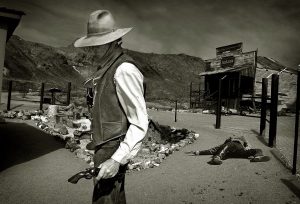 When we think of the outlaws of the old west, the term “gunfighter” or “gunslinger” were not the terms used to describe those men, or even the lawmen that some of them became upon changing their ways. They were actually originally called pistoleers, shootists, bad men, or one we do know…gunmen. That being said, Bat Masterson, who was a noted gunfighter himself, who later became a writer for the New York Morning Telegraph, sometimes referred to them as “gunfighters,” but, more often as “man killers.”
When we think of the outlaws of the old west, the term “gunfighter” or “gunslinger” were not the terms used to describe those men, or even the lawmen that some of them became upon changing their ways. They were actually originally called pistoleers, shootists, bad men, or one we do know…gunmen. That being said, Bat Masterson, who was a noted gunfighter himself, who later became a writer for the New York Morning Telegraph, sometimes referred to them as “gunfighters,” but, more often as “man killers.”
I suppose that Bat Masterson was probably the one who coined the term “gunfighter” in the first place, but many people from that era must have thought it an odd term to use. Still, if you heard an outlaw called a pistoleers, wouldn’t you have wondered what that was supposed to be? I would have, but then I would have looked it up and found that a pistoleers was “a soldier armed with a pistol.” That would have made no sense to me either, but in reality, some of the outlaws were soldiers who didn’t want to fight for a cause they didn’t believe in, so their deserted and headed west, so I guess they could have been pistoleers.
Another “movie mix-up” that happened is that in the old west, pistoleers or shootists didn’t squarely face off with each other from a distance in a dusty street, like they would like us to believe. In reality, the “real” gunfights of the Old West were rarely that “civilized.” Many fought in the many range wars and feuds of the Old West, which were far more common that the “stand-off” gunfight. Most of these were fought over land or water rights, some were political, and others were simply “old Hatfield-McCoy” style differences between families or in lifestyles. These people fought from the protection of anything available like a watering trough, a wall, building, or even a horse. Of those that more easily fit the perception of the “gunfighter,” you would find that they didn’t kill anywhere near the number of men they are credited with on television. In many instances their reputations stemmed from one particular fight, and the rumors grew from there, making people think they were that good. In other cases, self-promotion led people to believe they were lethal shootists, such was the case with Wyatt Earp and Wild Bill Hickok.
There were other, lesser known shootists, who actually saw just as much, if not more action than their well-known counterparts. Men like Ben Thompson, Tom Horn, Kid Curry, Timothy Courtright, King Fisher, Scott 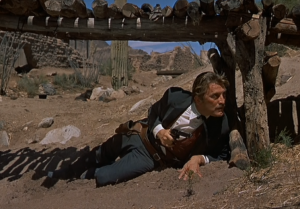 Cooley, Clay Allison, and Dallas Stoudenmire, just to name a few, were often not credited for nearly the shooting ability of the well known shooters. Often these gunfighters, whose occupations ranged from lawmen, to cowboys, ranchers, gamblers, farmers, teamsters, bounty hunters, and outlaws, were violent men who could move quickly from fighting one side of the law to the other, depending on what suited them best at the time. Though many of these gunman died of “natural causes,” many died violently in gunfights, lynchings, or legal executions. The average age of death was about 35. However, of those gunman who used their skills on the side of the law, they would persistently live longer lives than those that lived a life of crime.
Cooley, Clay Allison, and Dallas Stoudenmire, just to name a few, were often not credited for nearly the shooting ability of the well known shooters. Often these gunfighters, whose occupations ranged from lawmen, to cowboys, ranchers, gamblers, farmers, teamsters, bounty hunters, and outlaws, were violent men who could move quickly from fighting one side of the law to the other, depending on what suited them best at the time. Though many of these gunman died of “natural causes,” many died violently in gunfights, lynchings, or legal executions. The average age of death was about 35. However, of those gunman who used their skills on the side of the law, they would persistently live longer lives than those that lived a life of crime.
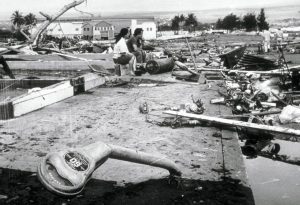 These days, scientist and inventors have collaborated to develop early warning systems for just about any possible disaster, and when everything works as it should, and people heed the warnings, loss of life can often be avoided. Having the technology is great, but technology can’t make human beings do the right things…unfortunately. On May 22, 1960, twelve years after tsunami warnings were developed, and with the warning system in good working order, a massive 9.5 earthquake struck off the coast of Chili. It was the largest earthquake ever recorded. Unfortunately, we don’t really have an earthquake warning, and so without warning, 1655 people lost their lives in Chili and 3,000 injured in the quake. Two million people were made homeless, and damage was estimated at $550 million. The earthquake, involving a severe plate shift, caused a large displacement of water off the coast of southern Chile at 3:11pm. Traveling at speeds in excess of 400 miles per hour, the tsunami moved west and north. On the west coast of the United States, the waves caused an estimated $1 million in damages, but were not deadly. Everyone assumed that the worst was over.
These days, scientist and inventors have collaborated to develop early warning systems for just about any possible disaster, and when everything works as it should, and people heed the warnings, loss of life can often be avoided. Having the technology is great, but technology can’t make human beings do the right things…unfortunately. On May 22, 1960, twelve years after tsunami warnings were developed, and with the warning system in good working order, a massive 9.5 earthquake struck off the coast of Chili. It was the largest earthquake ever recorded. Unfortunately, we don’t really have an earthquake warning, and so without warning, 1655 people lost their lives in Chili and 3,000 injured in the quake. Two million people were made homeless, and damage was estimated at $550 million. The earthquake, involving a severe plate shift, caused a large displacement of water off the coast of southern Chile at 3:11pm. Traveling at speeds in excess of 400 miles per hour, the tsunami moved west and north. On the west coast of the United States, the waves caused an estimated $1 million in damages, but were not deadly. Everyone assumed that the worst was over. 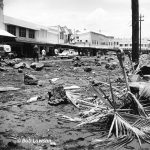
Nevertheless, warnings were sent to the Hawaiian islands. The Pacific Tsunami Warning System properly and warnings were issued to Hawaiians six hours before the wave’s expected arrival. The response of some people, however, was reckless and irresponsible. Some people ignored the warnings, and others actually headed to the coast in order to view the wave. Arriving 15 hours after the quake, only a minute after predicted, the tsunami destroyed Hilo Bay, on the island of Hawaii. Thirty five foot waves bent parking meters to the ground and wiped away most buildings, destroying or damaging more than 500 homes and businesses. A 10 ton tractor was swept out to sea. Reports indicate that the 20 ton boulders making up the sea wall were moved 500 feet. Sixty-one people died in Hilo, the worst-hit area of the island chain. Damage was estimated at $75 million. This tsunami caused little damage elsewhere in the islands, where wave heights were in the 3-17 foot range. The tsunami continued to race further west across the Pacific. Ten thousand miles away from the earthquake’s epicenter. Japan, received warning, but wasn’t able to warn the people in harm’s way. At about 6pm, more than a day after the quake, the tsunami hit the Japanese islands of Honshu and Hokkaido. The 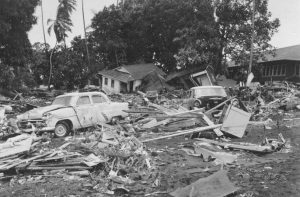 crushing wave killed 180 people, left 50,000 more homeless and caused $400 million in damages. The Philippines, also hit, saw 32 people dead or missing.
crushing wave killed 180 people, left 50,000 more homeless and caused $400 million in damages. The Philippines, also hit, saw 32 people dead or missing.
Tsunami warnings definitely save lives, but only if people will heed the warnings. As long as people decide that the warning doesn’t apply to them, and give in to their curiosity to go have a look, there will continue to be deaths. It seems a great shame that inventors and scientist work so hard to make a warning to save lives, and then some people refuse to do what is necessary to be safe after they have been warned. I simply don’t understand how people can ignore these warnings and take a chance with their lives.
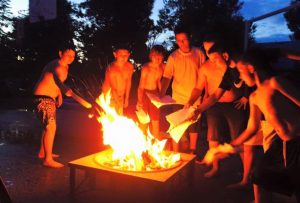
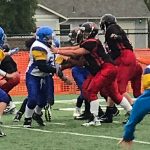 For my grandnephew, Xander Spethman, there is a specific tradition that goes along with his birthday every year. He gathers his friends together for a party. Now, I know that you are thinking, “What’s different about that?” Well, the difference is that they build a fire in his parents fire pit, and the boys burn their schoolwork from the year. Having a birthday so close to the end of the school year, it works out really well to have a school work burning party. This year will be slightly different, in that he will be burning the last year of his middle school career. As a boy, I don’t suppose that fact stirs up the emotions, like it does for his mom, but maybe it brings a bit of sadness that a certain time in his life has come to a close. Nevertheless, this has been a year of lasts. He has played his last middle school football game, and his last middle school basketball game. There will be a last time in the old school, and the last time (for awhile anyway) that he will be in school with his brother, Zack.
For my grandnephew, Xander Spethman, there is a specific tradition that goes along with his birthday every year. He gathers his friends together for a party. Now, I know that you are thinking, “What’s different about that?” Well, the difference is that they build a fire in his parents fire pit, and the boys burn their schoolwork from the year. Having a birthday so close to the end of the school year, it works out really well to have a school work burning party. This year will be slightly different, in that he will be burning the last year of his middle school career. As a boy, I don’t suppose that fact stirs up the emotions, like it does for his mom, but maybe it brings a bit of sadness that a certain time in his life has come to a close. Nevertheless, this has been a year of lasts. He has played his last middle school football game, and his last middle school basketball game. There will be a last time in the old school, and the last time (for awhile anyway) that he will be in school with his brother, Zack.
Of course, Xander is still very close with his family. He and his dad, Steve are best friends, and he is always so 
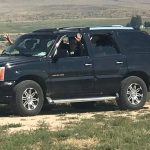 sweet to his mom, Jenny. He and his brothers, Zack and Isaac are also good friends, and his little sister, Aleesia is his little princess. His parents and siblings come to any and all his activities possible. It is a family tradition. Always be supportive of each other. Of course, that doesn’t mean that he and his brothers don’t fight, or that his sister never gets on his nerves, but Xander takes being the oldest very seriously. He works hard to be a leader and a good role model. And he does a good job of it too. His younger siblings look up to their brother and view him with a sense of pride. He shows them the right way to do things. Kids look up to their older siblings, and it is very important to make sure they are getting the right message from their older sibling, or they can end up in a lot of trouble down the road.
sweet to his mom, Jenny. He and his brothers, Zack and Isaac are also good friends, and his little sister, Aleesia is his little princess. His parents and siblings come to any and all his activities possible. It is a family tradition. Always be supportive of each other. Of course, that doesn’t mean that he and his brothers don’t fight, or that his sister never gets on his nerves, but Xander takes being the oldest very seriously. He works hard to be a leader and a good role model. And he does a good job of it too. His younger siblings look up to their brother and view him with a sense of pride. He shows them the right way to do things. Kids look up to their older siblings, and it is very important to make sure they are getting the right message from their older sibling, or they can end up in a lot of trouble down the road.
While this year is a year of lasts for Xander, it is also a year of firsts. This will be Xander’s first year of high school, Its a major change in a student’s life. Before long graduation will be right around the corner. This year has found Xander with a girlfriend, and to my knowledge, that is his first. He has signed up for ROTC, and I know he will do well with that, specially in the area of shooting accuracy, since Xander has been trained to be a great shot by his parents. Probably the biggest new thing in Xander’s life, however, will e the fact that since he 
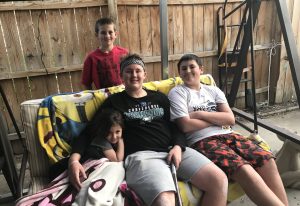 is now 15 years old, he will be getting his driver’s permit, so he can learn to drive. of course, his parents are excited to him to learn to drive, but they will also need to realize that they will most likely be relegated to the passenger side of the car…at least when Xander is in the car, because as we all know, 15 year olds need to drive!! There are a lot of changes coming his way, and we are so excited to see where life takes him next. Today is Xander’s 15th birthday. Happy birthday Xander!! Have a great day!! We love you!!
is now 15 years old, he will be getting his driver’s permit, so he can learn to drive. of course, his parents are excited to him to learn to drive, but they will also need to realize that they will most likely be relegated to the passenger side of the car…at least when Xander is in the car, because as we all know, 15 year olds need to drive!! There are a lot of changes coming his way, and we are so excited to see where life takes him next. Today is Xander’s 15th birthday. Happy birthday Xander!! Have a great day!! We love you!!

